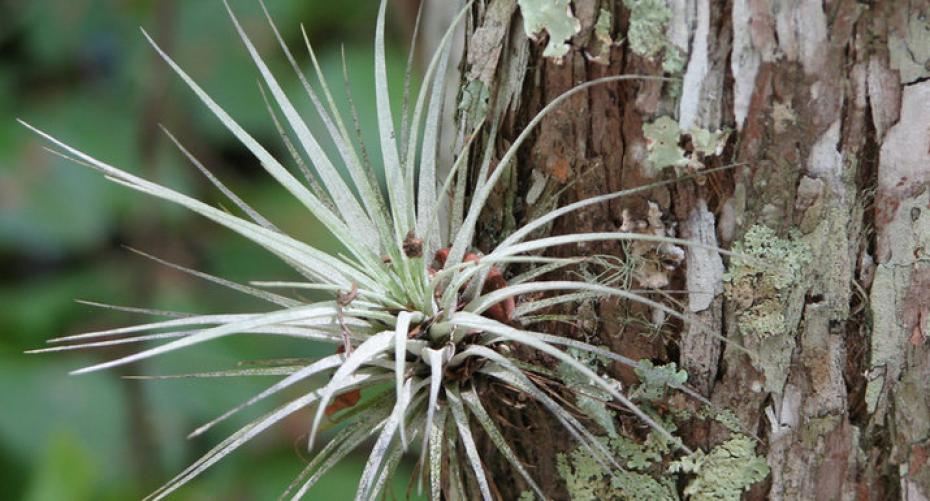Tillandsias,commonly known as Air Plants, are native from deserts, forests and mountain regions of Central and South America. They are part of the Bromeliad genus, and they are epiphytic (able to grow without soil). There are over 400 recognized species, with new varieties still being discovered. They live exclusively from air and water, from which they take all their necessary nutrients and moisture. This means that they don’t need to root themselves into the earth; instead they use their small rooting system to perch on rocks and trees. They vary greatly in size, shape and texture, producing beautiful flowers which vary in colour, from purples, reds, pinks, yellows and whites. The blooming cycle for some rapidly growing species may be only two or three weeks.
There are many different varieties to collect and they are displayed in a selection of different settings. Many feature popular wild birds, animals and family pets or you can choose from more natural settings including shells or driftwood. If you fancy having a go yourself we also stock the plants, moss, gravel and glue so you can make your own arrangement. Read our pointers on keeping air plants then start your collection this month!
Tillandsias which are kept in the house need to be watched closely in the initial month until they have established themselves in their new environment. They love fresh air, good light, and humidity - light kitchens and bathrooms are ideal, but not near a radiator or in the direct sun in the summer months. Alternatively, they can be grown under artificial light, fluorescent light is best but the plant should be within 6-36” from the tubes for less than 12 hours per day. If you see that your plant is not doing well in one position, try somewhere else. In mild weather air plants enjoy living outdoors in a sheltered position with good indirect or diffused sunlight. Rain is beneficial and the fresh air circulation will prevent any rot. If you go away on holiday we recommend that you leave them outside as long as temperatures will not drop below 10°C, in the winter they will look after themselves if you spray them before you leave. Feed weekly with air plant fertiliser in spring and summer, fortnightly in autumn and winter.
Watering is critical indoors since there is usually a lack of humidity, especially in homes or offices with air conditioning and/or central heating. Regulate spraying according to growing conditions, generous spray misting is sufficient as a means of watering in average weather conditions but additional watering will be required in a dry hot environment. The amount of watering required will vary according to temperature, light and air movement. As a guide, thoroughly wet your Tillandsia 2-3 times per week; more often in a hot, dry environment; less often in cool, humid conditions. Plants should be given enough light and air circulation and should dry in no longer than 4 hours after watering. Never use tap water where a water softener has been installed, rain water is ideal. A successful way to water loose plants which are dehydrating is to totally submerge them in room temperature rain water containing a small amount of fertiliser. They should remain submerged overnight or at least for a few hours. If submersion is not possible because they are glued to an arrangement, plants can be held under a running tap, but always shake off excess water as Tillandsias will not survive in standing water, this will cause the plant to rot. Under-watering is evident by an exaggerating of the natural concave curve of each leaf.
If you want to create your own arrangement care should be taken to avoid attaching the plant deep into a hole that will cover much of the base or by using too much moss wrapped around the base of a plant, both can block air circulation which will lead to plant rot. Apart from this you can mount plants on almost anything - driftwood, seashells, coral, rock, crystals. We recommend silicone rubber fixative to accomplish the task but care must be taken not to get fixative on the very base of the plant thus enabling any small roots to develop. As this fixative takes some hours to set, it is wise to use some kind of support to hold it in its place while it cures. An elastic band, wire or string is ideal. Hot glue can also be used, which dries in seconds. When hot glue is used, care must be taken with small species as the glue comes out of the gun at 190 °C. If the plant has a good root base on which to put the glue, the process should not be a problem if one is careful. One tip is to wait 10-30 seconds before attaching the plant; this gives the glue on the mounting surface a chance to cool a little.
Just remember, it is important to maintain Tillandsias properly: the key factors an equal balance of Light, Water, and Air Circulation.



![Kingsbury-bench-05[1].jpg](http://www.hayesgardenworld.co.uk/cdn/shop/files/Kingsbury-bench-05_5B1_5D.jpg?v=1712162737&width=1500)
![Kingsbury-bench-01[1].jpg](http://www.hayesgardenworld.co.uk/cdn/shop/files/Kingsbury-bench-01_5B1_5D.jpg?v=1712161065&width=1500)
![tw17a-4947_0[1].jpg](http://www.hayesgardenworld.co.uk/cdn/shop/files/tw17a-4947_0_5B1_5D.jpg?v=1712161495&width=1500)
![tw17a-4947_tenbury_5ft[1].jpg](http://www.hayesgardenworld.co.uk/cdn/shop/files/tw17a-4947_tenbury_5ft_5B1_5D.jpg?v=1712161172&width=1500)
![tw17a-4952_tenbury_4ft[1].jpg](http://www.hayesgardenworld.co.uk/cdn/shop/files/tw17a-4952_tenbury_4ft_5B1_5D.jpg?v=1712161034&width=1500)
![thumbnail_IMG_1565-kik_2[1].jpg](http://www.hayesgardenworld.co.uk/cdn/shop/files/thumbnail_IMG_1565-kik_2_5B1_5D.jpg?v=1712226536&width=1500)
![thumbnail_IMG_1565-kik_1[3].jpg](http://www.hayesgardenworld.co.uk/cdn/shop/files/thumbnail_IMG_1565-kik_1_5B3_5D.jpg?v=1712159637&width=1500)



![WD-XgESA[1].jpeg](http://www.hayesgardenworld.co.uk/cdn/shop/files/WD-XgESA_5B1_5D.jpg?v=1712159609&width=1500)